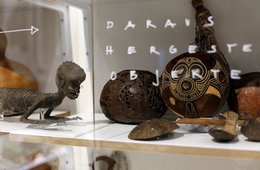text1
The sculptures had once been closely connected to the burial rituals of the Korean people where the little figurines used to decorate biers. In most cases, they put on a human shape and derive from the 19th century. In Korean, the word kokdu describes supernatural beings that help humans and act as a broker between this world and the afterlife. Their task was to accompany the deceased into the next world making their final journey as pleasant as possible. Although the reason for the artworks’ creation was sad, they convey a charm and vitality that is rather unique and that almost lets us forget their original function.








